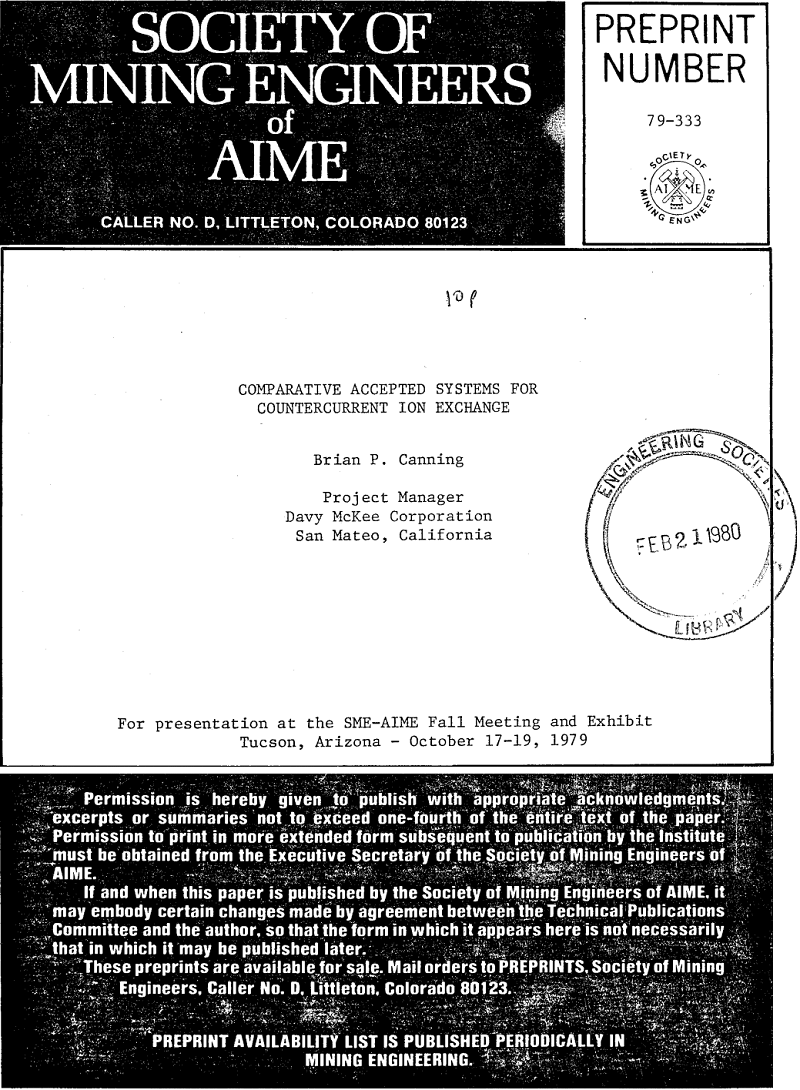Table of Contents
Resin-In-Pulp
The Federal American Contactor is currently being used by Federal American Partners, Union Carbide, and Western Nuclear. The system has a single stage per tank as in the Porter System.
It is not a fluidized bed system but a system in which the resin is maintained in a slurry suspension by mechanical agitation. The suspension is normally about 20 percent resin by volume. No feed distributor is required and all tanks can be installed at one elevation. Slurry is transferred tank to tank by airlifting the slurry to vibrating screens from which the oversize resin is discharged to the upstream tank and resin-free solution to the downstream tank. Solution flow is downward through the tank.
The resin stream is also recycled as required to obtain the required tank loading. The system is tolerant of slime solids up to 25 percent (highest of all systems considered). Coarse solids must be eliminated from the feed to permit efficient screen separation of the resin. The loaded resin is washed on a second stage of screens before transfer to elution. The system is particularly applicable to ores containing a high percentage of clay minerals which make liquid/solids separation difficult. It is interesting to note similarities of development of the carbon-in-pulp ion exchange process for gold recovery to development of the Resin-In-Pulp System.
Elution Systems
Except for the Chem-Sep System, loaded resin from the contactor is transferred to a separate vessel for elution. The Chem-Sep system is an integrated closed loop incorporating all steps of the process. Loaded resin in the case of the other contactor systems is delivered to elution in much the same manner or condition and can be eluted in a packed column elution system, a fluid bed system or an agitated slurry system.
With very low production rates batch elution is usually favored in fixed bed, packed columns, as little added resin inventory is required.
At higher production rates counter current columns are gaining in acceptance due to higher capacity, lower resin inventory, higher possible eluate strength and resin loadings. Countercurrent flow may be accomplished in packed or fluid bed columns. Elution systems must be provided with feed systems adaptable to the size and frequency of resin batches produced by the contactor(s). Usually the licenser of a contactor system includes the elution equipment of his preferred design as a package.
Packed Column Elution
Packed column elution can be done in batch columns or in a single plug flow column holding several resin batches moving countercurrently to the solution flow. The batch elution system usually requires two or three pressure columns which are filled and emptied of resin in a batch-wise manner. Transfer vessels are not necessarily required as contacted resin can be directly transferred and washed in the same elution vessel. Batch columns are eluted in series with eluting solution advancing counter-currently from column to column. Usually solution displacements and resin washing steps are also accomplished in the same columns in which case valving and instrumentation become complex. Solution flow is normally downward with collecting screens installed in the bottom of the column. Columns usually operate under 2 atmospheres pressure each stage or 6 atmospheres for a 3 stage unit. The higher the number of elution stages the higher the possible eluate concentration and the lower the possible return resin loading. The Himsley countercurrent column has plug flow of resin and operates in a similar manner to the Chem-Sep contactor. It requires a transfer vessel for solution displacement, resin washing and measurement of the loading charge. Resin is transferred to the column in strong eluate slurry and overflows the top of the column and returns to the exhaustion process. A transfer vessel may also be used for eluted resin if resin treatment is required. The system uses a downward flow of eluting solution with an upward plug flow movement of resin which is forced into the bottom of the column hydraulically. Interior resin screens at the bottom of the column collects the strong eluate and screens near the top of the column removes wash water or other resin treatment solution when this is designed. The column typically holds four to five contactor stage volumes of resin providing the equivalent of a similar number of batch type columns.
Fluid Bed Elution
The NIM system is a countercurrent multistage fluid bed column which uses an upflow of eluting solution and downflow of resin. The system is identical in operation to the NIM contactor previously described under “Exhaustion.” The resin is hydraulically transferred to the top of the column from a transfer vessel and dewatered on a vibrating screen before entering the column.
The resin may be washed in the transfer vessel. Eluted resin is transferred back to the exhaustion system using another transfer vessel for washing. The Utah system is a batch system utilizing vessels of the Utah contactor type described under “Exhaustion” with some dimensional differences. The system operates in a similar manner to batch columns except that it uses an upflow of solution through a fluid bed. Usually one or two stages are used. Resin is pumped to and from the elution process.
Agitated Slurry Type
The agitated slurry system used by Federal American is similar to the Resin-in-Pulp system described under “Exhaustion” but uses cone classifiers instead of screens for resin-solution separation between stages. Several stages are used with slurries up to about 70 percent resin by volume. Resin is usually pumped to and from the elution process.

